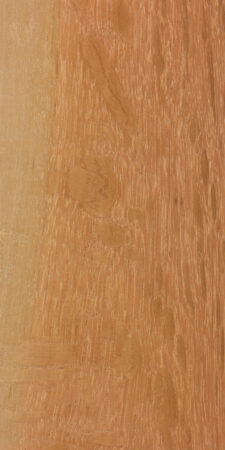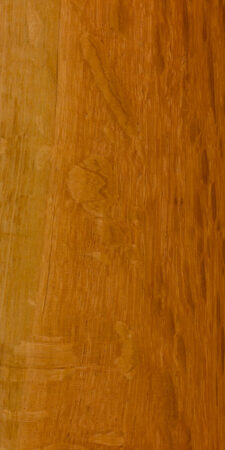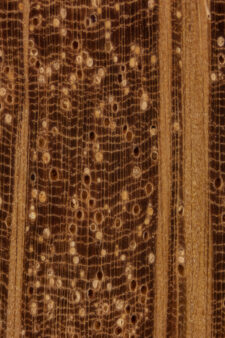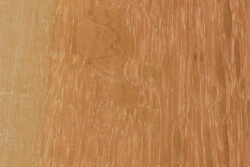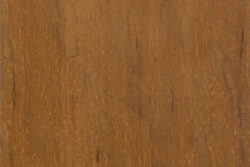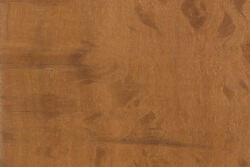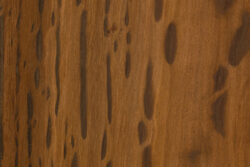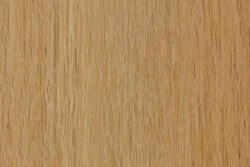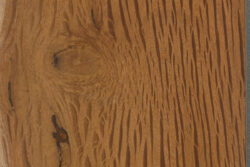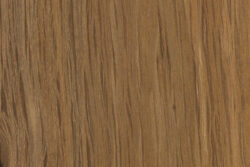Common Name(s): Rose sheoak, forest oak
Scientific Name: Allocasuarina torulosa (formerly Casuarina torulosa)
Distribution: Eastern Australia
Tree Size: 50-100 ft (15-30 m) tall,
2-3 ft (.6-1 m) trunk diameter
Average Dried Weight: 58.7 lbs/ft3 (940 kg/m3)
Specific Gravity (Basic, 12% MC): .81, .94
Janka Hardness: 3,150 lbf (14,000 N)
Modulus of Rupture: 21,030 lbf/in2 (145.0 MPa)
Elastic Modulus: 2,900,000 lbf/in2 (20.00 GPa)
Crushing Strength: 10,440 lbf/in2 (72.0 MPa)
Shrinkage: Radial: 2.8%, Tangential: 8.8%,
Volumetric: 11.7%, T/R Ratio: 3.1
Color/Appearance: Heartwood is pink to reddish brown. Somewhat well defined sapwood is a light yellowish brown. Very large rays produce a lace-like pattern on flatsawn surfaces (becoming even larger on quartersawn surfaces).
Grain/Texture: Grain is straight, with a uniform medium to fine texture and moderate natural luster.
Rot Resistance: Rated as durable; resistant to borers.
Workability: Despite its high density and hardness, rose sheoak’s straight grain give it a moderately good workability. However, the wood does have high initial shrinkage and should be dried carefully. Turns, glues, and finishes well.
Odor: No characteristic odor.
Allergies/Toxicity: Besides the standard health risks associated with any type of wood dust, no further health reactions have been associated with rose sheoak. See the articles Wood Allergies and Toxicity and Wood Dust Safety for more information.
Pricing/Availability: Generally unavailable outside of its natural range within Australia, supplies are limited to hobbyist and specialty applications domestically. Although the tree can attain medium to large sizes, it tends to be twisted or poorly formed, so long straight boards are uncommon.
Sustainability: This wood species is not listed in the CITES Appendices or on the IUCN Red List of Threatened Species.
Common Uses: Veneer, flooring, furniture, roof shingles and shakes, turned objects and other small, specialty wood items.
Comments: So named for its foliage, which turns a reddish-brown in autumn. The tree is also sometimes called forest oak, as it is found as an understory tree in eucalypt forests.
Not closely related to true oaks (Quercus genus), the etymology of the common name sheoak is ambiguous. Both oaks and sheoaks share a similar ray-flecked appearance on quartersawn surfaces.
Images: Drag the slider up/down to toggle between raw and finished wood.
Identification: See the article on Hardwood Anatomy for definitions of endgrain features.
Porosity: diffuse porous
Arrangement: exclusively solitary
Vessels: medium to large, few
Parenchyma: diffuse-in-aggregates, banded
Rays: narrow and very wide aggregate rays; normal and very wide spacing (respectively)
Lookalikes/Substitutes: The wide rays serve to separate Allocasuarina from most other genera (except for the closely related Casuarina genus). See notes below. Additionally, having exclusively solitary pores (rather than a mixture of solitary and radial multiples) further serves to differentiate sheoaks from other hardwood species.
Notes: Rose sheoak, along with most species contained in the Casuarinaceae family, feature aggregate rays that can be extremely wide—perhaps the widest of any hardwood family in the world. However, the aggregate rays found on rose sheoak tend to appear slightly more compact than those found in other Allocasuarina species.
Related Content:

